

About
History,Geography,Ecology,Wetlands
Gaomei In the Past
 Gaomei wetlands used to be called as Gaomi, which was one of the most important villages that the ancient Hans reclaimed in Middle Taiwan. It was renamed Gaomei during the Japanese occupation, which consisted of Gaomei, Gaodong, Gaosi, Gaonan, Gaobei. Long before the Hans reclaimed Gaomei district, it was a riverbed of Dajia River. Nowadays, we can tell it by seeing the farmers planting fields with stones in Gaomei.
Gaomei wetlands used to be called as Gaomi, which was one of the most important villages that the ancient Hans reclaimed in Middle Taiwan. It was renamed Gaomei during the Japanese occupation, which consisted of Gaomei, Gaodong, Gaosi, Gaonan, Gaobei. Long before the Hans reclaimed Gaomei district, it was a riverbed of Dajia River. Nowadays, we can tell it by seeing the farmers planting fields with stones in Gaomei.
In 1745, Yang, Wang, Xiao, and Chao, four families reclaimed the south of Gaomei, and the action started the fervency to colonize Gaomei, thereafter forming a lot of villages, such traditional villages as Chao village, Wang village, Xu village… ,etc.
In 1895, the Japanese came to Taiwan and began to rule here. In 1919, the Japanese founded “Mita Meritorious School Jiaochang” (Gaomei Elementary School). In 1932, Gaomei Sea-Water Baths, which was managed by Cingshui Street hall, started to operate and became one of the most important scenic spots, also the best place where many owners of factories treated their employee.
Gaomei Beach was shut down because the reconstruction of Taichung Harbor, which prompted the speed of silting and kept sightseers away. The silt gradually formed Gaomei Wetlands as we see now. The complex landforms are rich of biological resources and have become one of the most important habitats for migratory birds in Taichung. Recently, International Birds Alliance Conference (IBA) officially listed Gaomei Wetlands as the crucial habitat for migratory birds in Taiwan. However, because of the overexploitation of Dadu River and the destruction of the habitat, the rich ecology is endangered. ![]()
Geography Background
 There are three main rivers in Taichung County, namely, Daan river, Dajia river and Ou river from north to south. Among these rivers, Dajia river is the biggest one, in the south of which are the Gaomie wetlands and a fertile rice plain area. With a 3.5- km coast line covering only 300 hectares, Gaomie wetlands, nevertheless, comprise a very complex terrain. According to biological professor Hui Zhen Lin of Tunghai University, Gaomei wetlands are composed of seven kinds of terrain: tidal area, marsh area, sand area, gravel area, Yunlin Wando grass area, mud area and low water area. Because of the remote location, Gaomei wetlands were barely trodden by people and the diverse species could be preserved well before.
There are three main rivers in Taichung County, namely, Daan river, Dajia river and Ou river from north to south. Among these rivers, Dajia river is the biggest one, in the south of which are the Gaomie wetlands and a fertile rice plain area. With a 3.5- km coast line covering only 300 hectares, Gaomie wetlands, nevertheless, comprise a very complex terrain. According to biological professor Hui Zhen Lin of Tunghai University, Gaomei wetlands are composed of seven kinds of terrain: tidal area, marsh area, sand area, gravel area, Yunlin Wando grass area, mud area and low water area. Because of the remote location, Gaomei wetlands were barely trodden by people and the diverse species could be preserved well before. ![]()
Ecological Features
 Gaomei wetlands face Dajia River in the north, and the Cingshui water row,with the area approximately 300 hectares. Gaomei Wetlands bears most of the family organic wastewater in Cingshui, which provides an important source of nutrition for benthic organisms. In addition, the tidal River marsh, sand, gravel, and mudflats also offer a wealth of species an ideal habitat. For example, tide brook area is a place which gives birth to migratory fish. The slow flow area is the place for small fish’s shelter. The mudflats are the home of the mudskippers and the big- eye crabs. Sand area and Estuary are the playground of innocent fiddler crabs and textured fiddler crabs.
Gaomei wetlands face Dajia River in the north, and the Cingshui water row,with the area approximately 300 hectares. Gaomei Wetlands bears most of the family organic wastewater in Cingshui, which provides an important source of nutrition for benthic organisms. In addition, the tidal River marsh, sand, gravel, and mudflats also offer a wealth of species an ideal habitat. For example, tide brook area is a place which gives birth to migratory fish. The slow flow area is the place for small fish’s shelter. The mudflats are the home of the mudskippers and the big- eye crabs. Sand area and Estuary are the playground of innocent fiddler crabs and textured fiddler crabs.
Rich foods and the diversity of habitats support thousands of benthic organisms and birds, thereby providing a comfortable ground or relay station for the migratory birds to restore their energy after the long journey.
>Gaomei wetlands are just like a sponge, which can store the flood and then slowly discharges it to delay the passage of rainwater and to increase the amount of groundwater. It can also be the buffer to protect Gaomei embankment from being attacked by typhoon and big waves. Gaomei wetlands not only directly protect the lives and property of coastal residents, but also indirectly reduce flood damage, and keep the soil from being washed away or salinized. ![]()
Wetlands
What is wetland?
 A wetland is a land that is submerged in water or groundwater saturation permanently or seasonly, including swamps, marshes, bogs and shore, all able to support aquatic lives. These habitants are all biologically rich. And the three elements of wetland are wet soils, waters, and aquatic vegetation.
A wetland is a land that is submerged in water or groundwater saturation permanently or seasonly, including swamps, marshes, bogs and shore, all able to support aquatic lives. These habitants are all biologically rich. And the three elements of wetland are wet soils, waters, and aquatic vegetation.
The five basic categories of wetland are offshore wetlands, coastal wetlands, rivers wetlands, lakes wetlands, swamps wetlands, and ponds wetlands, but they don’t include permanent waters like rivers, lakes or ocean. The edge of the lake shallow waters, estuaries coastal areas are frequently submerged by a flood or tides are usually the most important part of wetland.
Gaomei wetlands were formed by the sediment left by flooded rivers. Besides, the erosion of river force and the accumulation of sediment also help make Gaomei a wetland like that appears near lakes and low lands.
Classification of wetlands
Wetland is roughly divided into natural wetlands and artificial wetlands. And natural wetlands fall into three categories: salt marshes, freshwater wetlands and semi-brackish. Gaomei wetlands are a semi-brackish one, which mostly happens in the tidal section of the river or estuary zone, such as Taipei Guandu mangrove wetland, Tatu River estuary wetland, and so on. This type of wetland attracts many birds to stay because of the dynamic ecosystem. Following are the introduction of the three kinds of wetlands:
(1)Natural Wetlands Include swamps, marshes, shoals, lagoons, etc. It can serve buffer floods, protect the coast, recharge groundwater, flourish fish and shellfish, and serve as a good site for tourism, recreation, educational and scientific research. In terms of environmental value, it can filtrate and precipitate pollution water, offers aquatic animals nutrients, and regulate climate.
(2)Artificial Wetlands are constructed artificially. It has widely been used to dispose of sewage by environmental scientists and engineers since 1970. This concept is to use the natural ecosystems in the wetland purification to achieve the purpose of pollutant removal in the artificial control.
The functions of wetlands
1. Provide wildlife and fish with a habitat, buffer flood, purify water, flourish natural lives, as well as serve a an ideal site for leisure and education.
2. Many rare and endangered animals mostly rely on the food supplied by wetlands to survive, while the majority of fishes, shrimps have also become an important food source for humans.
3. Wetlands can absorb and store flood, regulate water level. Even if the flood is usually out of control, the trees and grass in the wetland will retard flood speed to lessen the disaster.
4. Keep water, nutrients, filter chemical and organic wastes, and accumulate suspensions to purify water. ![]()
Environmental Protection
Foreword
 Several years ago, singer Xiao Jing-Teng filmed his new MV by burning a piano at Gaomei wetlands, thereby arousing our attention to the environmental issue. Then, we started doing research of Gaomei wetlands. We found that people bring damage and pollution to this ecology paradise full of various lives. By far, Gaomei wetlands already have many visitors. One Wetlands guide, Mr. Tsai, showed his concern that the wetlands are becoming harder because of too many visitors stepping on it, hence endangering the crabs used to live here. The garbage left by the holiday-goers is another vital damage to the precious region. The devastation to the wetlands is getting worse and worse day by day, spurring us to make this web page to intrigue more people’s care about Gaomei wetlands.
Several years ago, singer Xiao Jing-Teng filmed his new MV by burning a piano at Gaomei wetlands, thereby arousing our attention to the environmental issue. Then, we started doing research of Gaomei wetlands. We found that people bring damage and pollution to this ecology paradise full of various lives. By far, Gaomei wetlands already have many visitors. One Wetlands guide, Mr. Tsai, showed his concern that the wetlands are becoming harder because of too many visitors stepping on it, hence endangering the crabs used to live here. The garbage left by the holiday-goers is another vital damage to the precious region. The devastation to the wetlands is getting worse and worse day by day, spurring us to make this web page to intrigue more people’s care about Gaomei wetlands.
Lack of Management Office
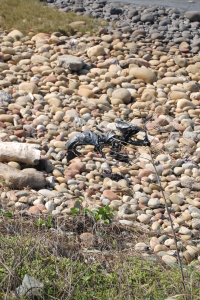
Gaomei wetlands was programmed as a wildlife refuge in 2004 and prohibited visitors to swim in the water. However, on December 23, 2001, we visited Gaomei wetlands, finding thatr there were no posted restrictions. Prior to the trip, we called the guide and questioned whether or not there were any restrictions or regulations we should know about. The guide’s response was “There’s no administration here.” Although it’s against the regulation, we could still enter the wetlands freely
The first convention on whether to integrate the wetlands into a national park was first held in 2010. They had the conclusion that Gaomei wetlands, with rich intertidal ecology and more than 120 species of birds inhabiting, is qualified as a nationally recognized wetland ecosystem. The administrate department of national park indicated that the Taichung County government should program it as refuge but did not execute the regulations strictly, but only posted a few signs and had the community volunteers help. Therefore, the ecosystem and environmental protections are hard to maintain and it causes the visitors, cars, and vendors to easily intrude. This is what needs to be dealt with immediately. Gaomei wetlands’ area is too small to meet the National Park standard. So if they want to set a national park service, there is still a lot to be discussed and evaluated.
Ecology expert, Yang Guo-Zhen thinks that because of our lack of understanding towards this special kind of ecosystem, the best way to protect it is not to disturb it. Given that people keep intruding and damaging the area, the wetlands will soon deteriorate and no longer return to its original state, consequently losing its ecology and tourism value forever.
The critical concern to the continuous damage has been talked about repeatedly these days, leading to a positive consequence that in March 2011 Taiwan government showed its determination to preserve the wetlands with only a part open to the tourists, hoping to end the harm to the land. However, too many tourists, showing no respect to the new regulations, have left too much garbage and keep intruding the forbidden reserve area.
Truly, it’s hard to take care of both the economy growth and environmental protection at the same time, yet it’s a pity people usually prefer the former eventually. Faced with the dilemma, we hope that people can change their idea in the long run and start to care more about the natural treasure which God gives us, like Gaomei wetlands. Only by respecting and protecting our nature can we lead a sustainable life and then get real benefit.
Garbage Problems

Besides the lack of decent management and the tourists’ reckless behavior, we found that around the dike is an area filled with instant noodle’s bowl, plastic bags and garbage, etc. Though it doesn’t occupy much place, the view like this is truly a stain of here. Although we once saw the cleaning groups picking up garbage, it still can’t prevent the environment from being polluted. Garbage destroying the environment is the problem to every tourist attraction; even the penalty cannot be fully implemented. The ultimate solution is to enhance people's public morality. It takes time but it’s worthwhile.
Take a trip!
Lighthouse

Gaomei Lighthouse is a red and white, octagonal, 38.7- meter high building, once was an important lighthouse for the sailing between the Taiwan Strait. Gaomei Lighthouse was built in May 1967. It spins once every 30 seconds and white light flashes three times continuously. Ships in the sea clearly know their direction because of this special light.
Gaomei Lighthouse was responsible for the safety of vessels, usually not open for people to visit. However, in 1982, due to the scarcity of Gaomei beach visitors, plus the construction of Taichung Harbor, the Gaomei Lighthouse was no longer on duty: the main light was reinstalled on the top floor of Taichung Harbor and the tower has retained so far. But the removal doesn’t affect the status of being a beautiful landmark. Around the lighthouse is the dormitory of National Tax Administration of Taichung Harbor. The entire buildings show a subtropical and British style, becoming a beautiful tourists’ attraction in Taiwan's west coast seaside, where people can get away the hustle and bustle of city life.
Gaomei Bicycle Path

Gaomei Bicycle Path is a beautiful path along Gaomei wetlands. The whole length is less than two kilometers, but you can not only view the wetland scenery, but also watch birds and watch sunset. and there’ll also be an ecology experience park. Although the beach has less shade, people cycling here can enjoy the thrill of riding against the ocean breeze.
Wind Power

With the wind strength suitable for wind power, There are 18 generators, 65 meters high with the blade’s diameter 68.6 meters, built in Gaomei wetlands, total number 22 plus those in the Taichung power station. There are two rows, 10 outside and 8 inside.
Related News: Five generators shut down, Taipower’s wind turbine like a model.
Taipower sets 22 wind turbines in Gaomei wetlands and in Taichung Power Plant, but five of them have been shut down. This led to Taichung Council member Mr. Chen’s strong dissatisfaction. He criticized it as an impractical “model”. Mr. Chen, the director of New Energy Construction Department, said that it is the pain of Taipower’s people. It has been actively repaired, in the hope of returning to full operations by next spring. In order to respond the government's green energy policy, Taipower sets 22 wind turbines in Gaomei wetlands and Taichung Power Plant. One out of 18 in Gaomei wetlands collapsed when the typhoon struck last year, and another 5 have been infuctional. Taipower has set 162 electricity windmills in Taiwan, which were constructed by Dutch manufacturers in 1992. Two years later, the Japanese took over, and Japanese companies also then transferred to the South Korean companies. Eventually, these windmills now face the problems of the shortage of parts and poor-quality maintenance.
The Tide Table
Lunar calandar |
high wate |
low water |
tide |
|
1 |
16 |
11:15 |
05:39 |
spring tide |
2 |
17 |
12:03 |
06:27 |
|
3 |
18 |
12:51 |
07:15 |
|
4 |
19 |
13:39 |
08:03 |
|
5 |
20 |
14:27 |
08:51 |
medium tide |
6 |
21 |
15:15 |
09:39 |
|
7 |
22 |
16:03 |
10:27 |
|
8 |
23 |
16:51 |
11:15 |
neap tide |
9 |
24 |
17:39 |
12:03 |
|
10 |
25 |
18:27 |
12:51 |
|
11 |
26 |
19:15 |
13:39 |
|
12 |
27 |
20:03 |
14:27 |
long tide |
13 |
28 |
20:51 |
15:15 |
|
14 |
29 |
21:39 |
16:03 |
|
15 |
30 |
22:27 |
16:51 |
|
 Quoted
Quoted
Biology
Animals
The Fiddler Crab
The fiddler crab is one of the main creatures in Gaomei wetlands, and it plays an important role in the wetland ecology. The fiddler crab has the most population in comparison with the other crabs in the Mangrove forest. In addition to being a great cleaner, the fiddler crab is a major food source for the wild birds in the wetland.
Fiddler crabs have a peculiar outlook. The male crabs are easily recognized by their distinctively asymmetric claws. They usually wave their huge ones to scare away their enemies or use it in clashes of ritualized combat of courtship over a female. The crab has its name because the movement of waving the claw is like fiddling the violin. The crab's smaller claw picks up a chunk of sediment from the ground, and after anything edible is absorbed, the sediment left is in the form of a little ball.
These are some common fiddler crabs below.
Ucaarcuata
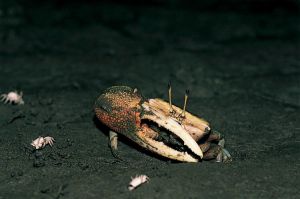 Due to the curve side on its carapace, it is also called the Curve Sided Fiddler Crab. It has the ability to build a small circle of clay bank near the hole just like a tiny crater, and it likes to live on the mud which the tide won’t submerge.
Due to the curve side on its carapace, it is also called the Curve Sided Fiddler Crab. It has the ability to build a small circle of clay bank near the hole just like a tiny crater, and it likes to live on the mud which the tide won’t submerge.
Ucalactea
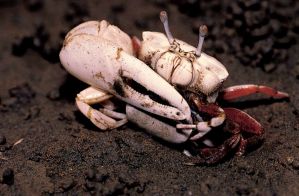 This kind of fiddler crab is a bit smaller than the other ones while it is only the size of our thumb knuckle. The male crabs have a huge white claw, and its carapace will turn from pure white to dark gray when influenced by the morning and evening tides. It is very active, and will come out to exercise during the ebb. So unique it is that the little mud balls it makes around the hole spread radially.
This kind of fiddler crab is a bit smaller than the other ones while it is only the size of our thumb knuckle. The male crabs have a huge white claw, and its carapace will turn from pure white to dark gray when influenced by the morning and evening tides. It is very active, and will come out to exercise during the ebb. So unique it is that the little mud balls it makes around the hole spread radially.
Uca borealis
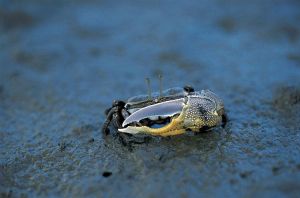 The most apparent characteristic of this crab is that the huge claws have the color of orange or light red. It is approximately as big as a third of a person’s palm of the hand. It mostly perches at the border district of the tide, and likes to construct a place to live (a hole) which is 5 to 10 meters higher than the water surface.
The most apparent characteristic of this crab is that the huge claws have the color of orange or light red. It is approximately as big as a third of a person’s palm of the hand. It mostly perches at the border district of the tide, and likes to construct a place to live (a hole) which is 5 to 10 meters higher than the water surface.
The Mudskipper
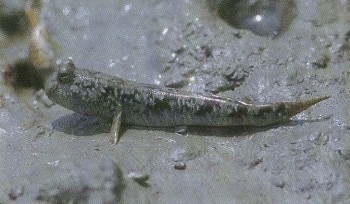 There is a regular habitant, the mudskipper, in Gaomei wetlands. When the tide rises up, the mudskipper with a gesture of fishing in the air climbs along the rock in the mangrove forest. The mudskipper is a species, genus of amphibian, with a marl body and bulging eyes. The mudskipper can not only breathe with gill in the water but also can exchange the air with moist skin in the land. The mudskipper is able to use his tail to bounce on the surface of water and to crawl on the land with his fleshy pectoral fin. In the period of breeding, the male mudskipper always raises up his dorsal fin to attract the female one.
There is a regular habitant, the mudskipper, in Gaomei wetlands. When the tide rises up, the mudskipper with a gesture of fishing in the air climbs along the rock in the mangrove forest. The mudskipper is a species, genus of amphibian, with a marl body and bulging eyes. The mudskipper can not only breathe with gill in the water but also can exchange the air with moist skin in the land. The mudskipper is able to use his tail to bounce on the surface of water and to crawl on the land with his fleshy pectoral fin. In the period of breeding, the male mudskipper always raises up his dorsal fin to attract the female one.
Bo-leophthalmus boddaerti
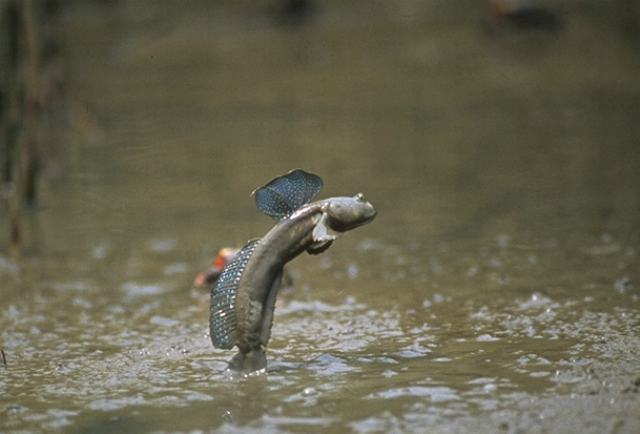 The big mudskipper, so-called bo-leophthalmus boddaerti, lives on the algae and crumbs in the mud with a blue fluorescent body. The pectoral fin of the big mudskipper ,like a crutch, helps to bounce or crawl. When the tide wades, the mudskipper crawls out from the cave.
The big mudskipper, so-called bo-leophthalmus boddaerti, lives on the algae and crumbs in the mud with a blue fluorescent body. The pectoral fin of the big mudskipper ,like a crutch, helps to bounce or crawl. When the tide wades, the mudskipper crawls out from the cave.
 Quoted
QuotedLittle Egret
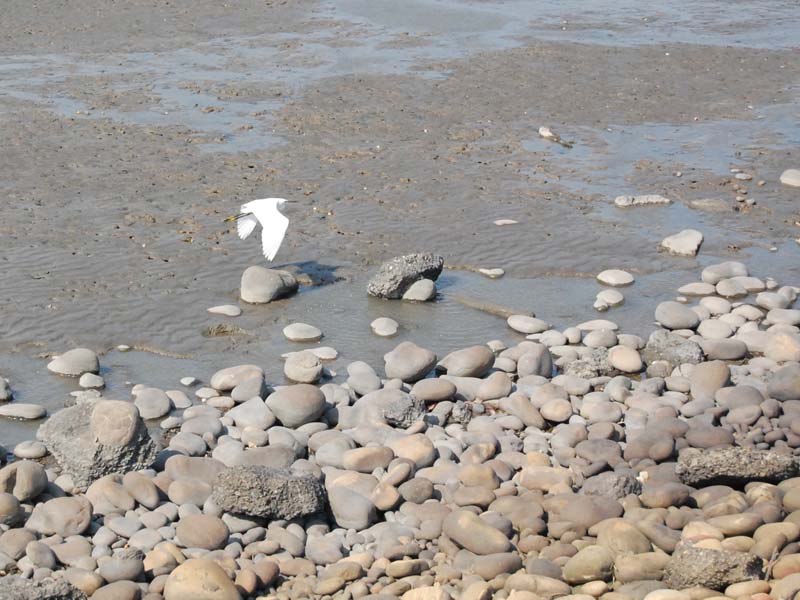 We can usually see a herd of egrets perch in the tidal flat in Gaomei wetlands. The features of egret are white body, black beak and feet, red eyes, and yellow-green fingers. Sometimes the egret gives off hoarse and quack sound. They live on fish and shrimps and move in flocks in the swamp, rice field, and tidal flat. The egret flaps the wings and stirs with the feet in the water to scare the fish and shrimps for preying on them.
We can usually see a herd of egrets perch in the tidal flat in Gaomei wetlands. The features of egret are white body, black beak and feet, red eyes, and yellow-green fingers. Sometimes the egret gives off hoarse and quack sound. They live on fish and shrimps and move in flocks in the swamp, rice field, and tidal flat. The egret flaps the wings and stirs with the feet in the water to scare the fish and shrimps for preying on them.
The egret is usually found out in the level ground and low-elevation creek, water rice field, and fishing and emigrate to the south in the winter.![]()
Plants
Kandelia
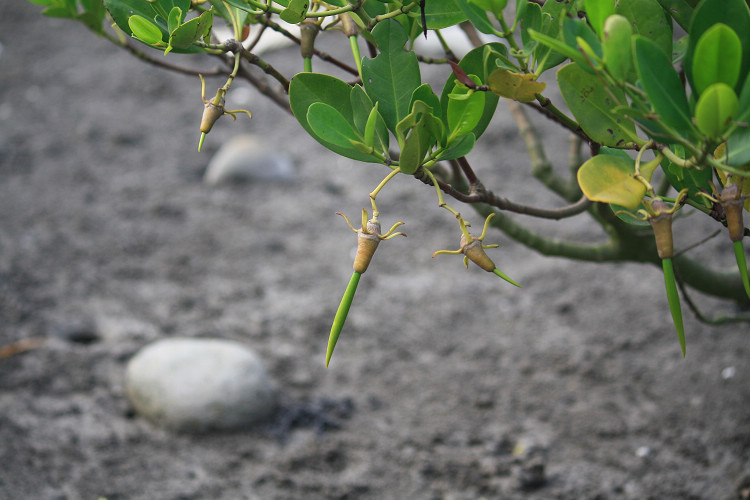 KandeliaKandelia, a kind of viviparous plant, is named by its hypocotyl resembling as a pen. The leaf shape of kandelia is rectangle. The flower season of the kandelia is from May to June. The flowers grow like conical fruits when they wither away. The fruits would not fall down and stick to the trunk of the tree instead. The fruits grow as seedlings by absorbing the nutrition of the tree. The ripe and pen-like seedlings fall down until the spring comes next year and plug into the muddy land. After two years, the ripe seedlings bloom and propagate its generations.
KandeliaKandelia, a kind of viviparous plant, is named by its hypocotyl resembling as a pen. The leaf shape of kandelia is rectangle. The flower season of the kandelia is from May to June. The flowers grow like conical fruits when they wither away. The fruits would not fall down and stick to the trunk of the tree instead. The fruits grow as seedlings by absorbing the nutrition of the tree. The ripe and pen-like seedlings fall down until the spring comes next year and plug into the muddy land. After two years, the ripe seedlings bloom and propagate its generations.
One of the most useful functions of kandelia for the ecology is to buffer strong winds and keep sand.
Kandelia is not an original plant in Gaomei wetlands and on the contrary was planted by people purposefully. The kandelia in Gaomei wetlands is preserved for the purpose of education now. ![]()
Bolboschoenus planiculmis
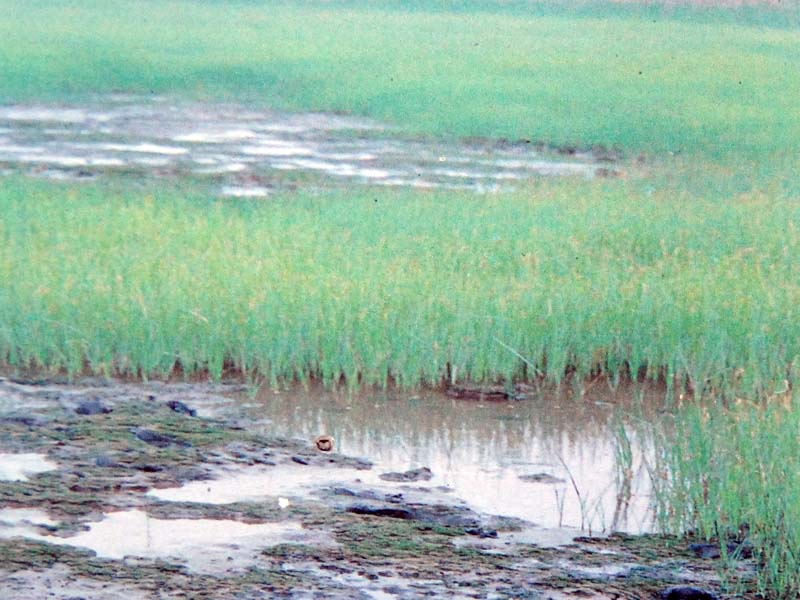 The Bolboschoenus planiculmis is a herbaceous plant. The bolboschoenus planiculmis grows in July, matures in August, and fades in October every year in Taiwan. The bolboschoenus planiculmis thrives well because of its saltbush and subterranean stem. The area of bolboschoenus planiculmis is 5 hectares in Gaomei wetlands according to the statistics of 2000. Now the Gaomei wetlands is the only place to plant the bolboschoenus planiculmis in central Taiwan.
The Bolboschoenus planiculmis is a herbaceous plant. The bolboschoenus planiculmis grows in July, matures in August, and fades in October every year in Taiwan. The bolboschoenus planiculmis thrives well because of its saltbush and subterranean stem. The area of bolboschoenus planiculmis is 5 hectares in Gaomei wetlands according to the statistics of 2000. Now the Gaomei wetlands is the only place to plant the bolboschoenus planiculmis in central Taiwan. ![]()
Da-Ann Hygrophila
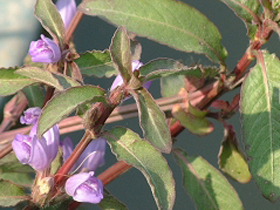 Da-Ann Hygrophila is a special hydrophytic plant in Taiwan and grows near the water of ditch and pond. The features of Da-Ann Hygrophila are its rectangular stem, pone leaves, and pink flowers. The period of blooming is during the seasons of autumn and winter(from August to December). Da-Ann Hygrophila is usually rooted out because of its uselessness. Besides, Da-Ann Hygrophila thrive very well in Gaomei wetlands on virtue of its character of agamogenesis .
Da-Ann Hygrophila is a special hydrophytic plant in Taiwan and grows near the water of ditch and pond. The features of Da-Ann Hygrophila are its rectangular stem, pone leaves, and pink flowers. The period of blooming is during the seasons of autumn and winter(from August to December). Da-Ann Hygrophila is usually rooted out because of its uselessness. Besides, Da-Ann Hygrophila thrive very well in Gaomei wetlands on virtue of its character of agamogenesis .![]()
 Quoted
Quoted
Quote
-
“About Gaomei” reference information
How are wetlands formed? –Yahoo! Knowledge TW Definition of wetlands
-
“Biology” reference information
Natural ecological network Blog Fiddler crab - Introduction Taiwan fiddler crab illustrations Mudskippers and Kandelia – Yahoo! Knowledge TW 07-102 Mudskipper Little Egret 3Little Egret Kinmatsu's Realms-Kandelia Kandelia candel (L.) Druce Kandelia1 Google search for picture results Small files of the Da-Ann Hygrophila’s life Bolboschoenus planiculmis -
“Walk Around”reference information
Panoramio - Photo of Gaomei Lighthouse Gaomei wetlands Bird-watching fun Introduction- Taichung- Humanism cram school- Yahoo! Blog Gaomei wetlands eco-tourism information network - Gaomei Lighthouse Five generators shut down, Taipower’s wind turbine like a model.- Yahoo! Search engine Google Images Gaomei Bicycle Path- Random nest tourism Xuite Gaomei wetlands @BuBuChen’s travel notebook :: PIXNET ::
Memories in
GaomeiWetlands

Memories in
GaomeiWetlands

Memories in
GaomeiWetlands

Memories in
GaomeiWetlands

Memories in
GaomeiWetlands

Memories in
GaomeiWetlands

Memories in
GaomeiWetlands

Memories in
GaomeiWetlands

Memories in
GaomeiWetlands

Memories in
GaomeiWetlands

Memories in
GaomeiWetlands

Memories in
GaomeiWetlands

Memories in
GaomeiWetlands

Memories in
GaomeiWetlands

Memories in
GaomeiWetlands

Memories in
GaomeiWetlands

Memories in
GaomeiWetlands

Memories in
GaomeiWetlands

Memories in
GaomeiWetlands

Memories in
GaomeiWetlands

Memories in
GaomeiWetlands

Memories in
GaomeiWetlands

Memories in
GaomeiWetlands

Memories in
GaomeiWetlands

Memories in
GaomeiWetlands

Memories in
GaomeiWetlands

Memories in
GaomeiWetlands

Memories in
GaomeiWetlands

Memories in
GaomeiWetlands

Memories in
GaomeiWetlands

Memories in
GaomeiWetlands

Memories in
GaomeiWetlands

Memories in
GaomeiWetlands

Memories in
GaomeiWetlands

Memories in
GaomeiWetlands

Memories in
GaomeiWetlands

Memories in
GaomeiWetlands

Memories in
GaomeiWetlands

Memories in
GaomeiWetlands

Memories in
GaomeiWetlands

Memories in
GaomeiWetlands

Memories in
GaomeiWetlands

Memories in
GaomeiWetlands

Memories in
GaomeiWetlands

Memories in
GaomeiWetlands

Memories in
GaomeiWetlands

Memories in
GaomeiWetlands

Memories in
GaomeiWetlands

Memories in
GaomeiWetlands

Memories in
GaomeiWetlands

Memories in
GaomeiWetlands

Memories in
GaomeiWetlands

Memories in
GaomeiWetlands

Memories in
GaomeiWetlands

Memories in
GaomeiWetlands

Memories in
GaomeiWetlands

Memories in
GaomeiWetlands

Memories in
GaomeiWetlands

Memories in
GaomeiWetlands

Memories in
GaomeiWetlands

Memories in
GaomeiWetlands

Memories in
GaomeiWetlands

Memories in
GaomeiWetlands

Memories in
GaomeiWetlands

Memories in
GaomeiWetlands

Memories in
GaomeiWetlands

Memories in
GaomeiWetlands

Memories in
GaomeiWetlands

Memories in
GaomeiWetlands

Memories in
GaomeiWetlands

Memories in
GaomeiWetlands

Memories in
GaomeiWetlands

Memories in
GaomeiWetlands

Memories in
GaomeiWetlands

Memories in
GaomeiWetlands

Memories in
GaomeiWetlands

Memories in
GaomeiWetlands

Memories in
GaomeiWetlands

Memories in
GaomeiWetlands

Memories in
GaomeiWetlands

















































































